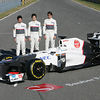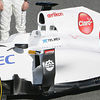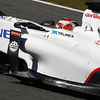Analysis: Sauber C31

Sauber have today presented their new C31, a car again powered by a Ferrari V8. Other than that however, little was left unchanged, as the team tackled the challenge of improvement and the adoption of the regulation changes in its very own way.
Although James Key has now left Hinwill, Sauber's former technical director surely had his influence on this car. Just like its predecessor, the Sauber C30 it is an aerodynamically very clean design, with little impressive features at first sight.
When looking a bit closer though, there are several items of interest, some if which cannot be entirely explained as all teams try to hide their novelties as long as they can to slow the copycats down.
At the front of the car, there is of course the new nose, which needed to be a maximum of 550mm above the reference plane. The well known step is clearly visible, despite its dark grey painting. What Sauber have done however is try to reduce the turbulence generated just behind the bump by added a small aperture in the upper surface of the nose cone. While it is not clear on the launch car where Sauber is going to get air from, a stream like this, flowing from the bump towards the driver's visor can help reduce the drag that the bump in the nose would induce.
Despite some question marks, Sauber have surely thought about solving this bump issue, or at least try to make the most aerodynamic benefit out of it as possible.
Attached to this new nose is a front wing extremely similar to what was raced at the end of 2011. Is is a common 3 element wing with an additional stacked element above it. The endplates consist of two vertical panels, both swirling away from the car's centreline in an attempt to direct air around the front wheels.
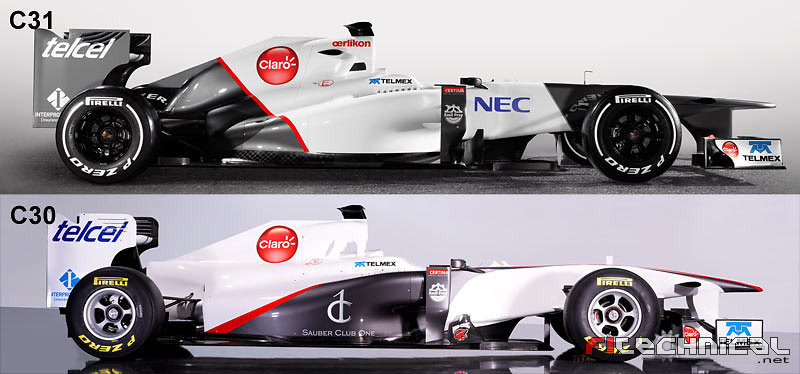
The chassis itself has also been tackled in order to make it aerodynamically more efficient within the new ruleset. Last year's C30 actually had a very high front bulkhead, with the top of the nose running upwards from the cockpit towards the front of the car, before dropping down between the front wheel centreline and the nosetip. As retaining this shape would create an even higher step in the nosecone, Sauber decided to slope down the monocoque slightly - rather than upwards - to a hight almost identical to the height of the upside of the front tyres. With the added step down to 550mm, the nosetip is at the same height as it was on the Sauber C30.
Around the cockpit, the driver's side protection has become a little bit more rounded, while the roll hoop structure has remained largely the same. Sauber have retained their already largely undercut airbox, albeit now a little more rounded at the top.
The smaller air inlet under the main inlet however has been drastically increased in size. Where it could hardly fit a golf ball, its aperture size has not at least doubled, while a small horizontal splitter into the hole seems to suggest air is divert to two different areas. Usually, this type of inlet is destined to pass through a small gearbox oil cooler behind the engine.
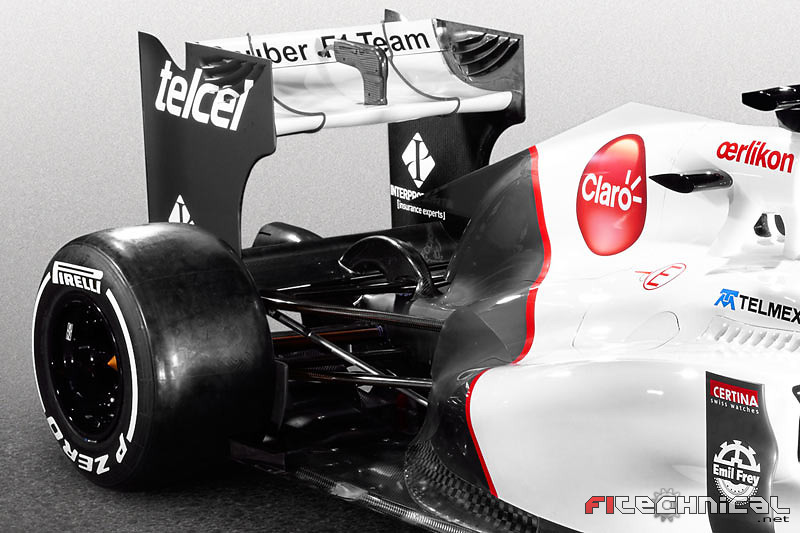 The sidepods meanwhile still feature a large undercut at the front. The bargeboard ahead has grown a little, and the sidepod panel underwent some development, including the addition of another small winglet attached to the car's floor. The inlet of the sidepod is again split into two parts, with the lower small inlet likely aimed at cooling the KERS system.
The sidepods meanwhile still feature a large undercut at the front. The bargeboard ahead has grown a little, and the sidepod panel underwent some development, including the addition of another small winglet attached to the car's floor. The inlet of the sidepod is again split into two parts, with the lower small inlet likely aimed at cooling the KERS system.
The rear end is certainly where most of the development time went to. With the sidepods now sloping down faster, the beam wing and diffuser will be fed with a better and more clean airflow, improving their efficiency. Sauber's chief designer also mentioned that the team kept its cooling concept, so held on to a similar radiator position and sidepod outlets. Contrary to most other teams who went for a tail funnel, Sauber still have sidepod outlets on each side of the car. The openings are narrow and high, exiting close to the car's centreline. Previously they also included the exhaust exits, but those have nose been relocated to the upper surface of the sidepod, quite a bit upstream of the hot air outlets.
Sauber have also redesigned their gearbox casing to be smaller and a little longer than last year to make sure air can cleanly flow under the beam wing and way from the car. To further enhance this, the beam wing is now supported by a thick swan neck, similar to the Virgin Racing VR-01. Instead of two supports however, Sauber has a single one, raising the suggestion that this might also be an air channel that pushes air out underneath the beam wing. Again, this has not been confirmed yet, but it's a possibility.
Finally interesting to note is Sauber's change to a pull rod rear suspension, just like Ferrari after retaining the rear push rod last year. The pull rod, the lower suspension arms and the frontal upper wishbone all connect to the gearbox, while the rear upper wishbone connects to the swan neck that supports the rear wing.


